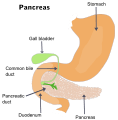Pancreatitis facts for kids
Quick facts for kids Pancreatitis |
|
|---|---|
 |
|
| The pancreas and surrounding organs | |
| Symptoms |
|
| Complications | Infection, bleeding, diabetes mellitus, pancreatic cancer, kidney failure, breathing problems, malnutrition |
| Duration | Short or long term |
| Causes | |
| Risk factors | Smoking |
| Diagnostic method | Based on symptoms, blood amylase or lipase |
| Treatment | Intravenous fluids, pain medication, antibiotics |
| Frequency | 8.9 million (2015) |
| Deaths | 132,700 (2015) |
Pancreatitis is a medical condition where your pancreas becomes inflamed. The pancreas is a large organ located behind your stomach. It helps your body digest food by making digestive enzymes. It also produces important hormones, like insulin, which controls blood sugar.
There are two main types of pancreatitis: acute pancreatitis and chronic pancreatitis. Acute pancreatitis means it starts suddenly and usually gets better in a few days. Chronic pancreatitis means it lasts a long time or keeps coming back.
Contents
What Causes Pancreatitis?
Common Reasons for Acute Pancreatitis
The two most common reasons for acute pancreatitis are gallstones and certain unhealthy drinking habits. A gallstone can block the common bile duct, which is a tube that carries digestive fluids. This blockage can cause problems for the pancreas.
Other things that can cause acute pancreatitis include injuries to the abdomen, certain medications, and infections like mumps. Sometimes, tumors can also be a cause.
Why Chronic Pancreatitis Develops
Chronic pancreatitis can sometimes happen after many attacks of acute pancreatitis. It is often linked to unhealthy drinking habits over many years.
Other causes include high levels of fats or calcium in your blood. Some medications and certain genetic disorders, like cystic fibrosis, can also lead to chronic pancreatitis. Smoking can increase your risk for both types of pancreatitis.
How Do Doctors Diagnose Pancreatitis?
To find out if someone has acute pancreatitis, doctors look at their symptoms. They also do blood tests to check for high levels of certain enzymes, like amylase or lipase. These enzymes are usually much higher than normal when the pancreas is inflamed.
For chronic pancreatitis, these blood tests might be normal. So, doctors might use Medical imaging tests. These include ultrasound and CT scans. These scans help them see what the pancreas looks like.
Signs and Symptoms of Pancreatitis
The most common symptom of pancreatitis is severe pain. This pain is usually in the upper part of your abdomen and can spread to your back. It often feels worse after you eat.
You might also feel nausea (feeling sick to your stomach) and vomiting. If you have acute pancreatitis, you might also have a fever. These symptoms usually get better in a few days.
With chronic pancreatitis, people might lose weight without trying. They can also have fatty stool (poop that looks greasy) and diarrhea. This happens because the pancreas isn't making enough enzymes to digest food properly.
Other Physical Signs
When a doctor examines someone with pancreatitis, they might find that the abdomen is tender to touch. Your heart rate and respiratory rate (how fast you breathe) might be higher than normal. Your blood pressure could also be high due to pain or low due to dehydration.
Sometimes, a fever or jaundice (yellow skin or eyes) can be present. If chronic pancreatitis continues, it can lead to serious problems like diabetes or even pancreatic cancer.
Possible Complications
Pancreatitis can lead to other health problems. Early complications can include shock, infections, and dehydration. It can also cause low blood calcium or high blood sugar.
Severe inflammation can affect your kidneys, leading to kidney failure. Breathing problems are also common. Fluid can build up around the lungs, making it hard to breathe.
Later complications can include repeated attacks of pancreatitis. Sometimes, fluid-filled sacs called pancreatic pseudocysts can form near the pancreas. These can cause pain, get infected, or even burst. In very serious cases, a pancreatic abscess (a collection of pus) can form.
How is Pancreatitis Treated?
Treating Acute Pancreatitis
If you have acute pancreatitis, doctors usually give you intravenous fluids (fluids through a vein). They also give pain medication to help with the severe pain. Sometimes, antibiotics are needed if there's an infection.
If a gallstone is blocking a duct, a special procedure called an endoscopic retrograde cholangiopancreatography (ERCP) might be done. This helps doctors remove the gallstone. Often, the gallbladder is also removed to prevent future problems.
Treating Chronic Pancreatitis
For chronic pancreatitis, treatments include those for acute pancreatitis. Sometimes, a special tube called a nasogastric tube is used to give you food if you can't eat normally.
People with chronic pancreatitis often need to make long-term changes to their diet. They might also need to take pancreatic enzyme replacement pills. These pills help their body digest food. In some cases, surgery might be needed to remove parts of the pancreas.
Pancreatitis Around the World
In 2015, about 8.9 million people worldwide had pancreatitis. Sadly, it led to about 132,700 deaths that year.
Acute pancreatitis affects about 30 out of every 100,000 people each year. Chronic pancreatitis is less common. It affects about 8 new people per 100,000 each year. In the United States, about 50 out of every 100,000 people currently live with chronic pancreatitis.
It is more common in men than in women. Chronic pancreatitis often starts between the ages of 30 and 40. It is quite rare in children.
Pancreatitis in Animals
Did you know that dogs can also get pancreatitis? Eating too many fatty foods can sometimes cause canine pancreatitis in dogs.
Images for kids


